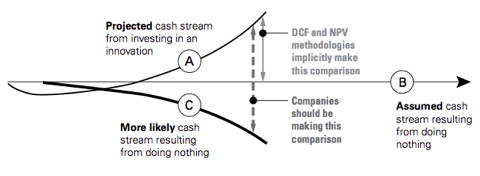When it comes to innovation and new market opportunity — why some companies harness those forces to catapult to riches and glory, while otherwise good and strong leaders stumble and fall — the smartest guy I’ve ever met is Clay Christensen.
The chart above is from an article Clay wrote a year or so ago, Innovation Killers: How Financial Tools Destroy Your Capacity to Do New Things.
You might be saying, “I’m in marketing, not finance…”
But stay with me on this, because this chart gets to the heart of the problem in dealing with disruptive innovation. And, as you’ve probably noticed, the entire marketing world is in the middle of a colossal cluster-flock of disruptive innovation.
When a company is trying to decide whether to do something new — hire new people, adopt new tools, develop a new channel, or invest in any new project of any significance that’s different than the status quo — someone usually ends up doing a cash flow analysis on it.
Maybe they try to calculate its net present value (NPV) or internal rate of return (IRR). Or maybe it’s just an informal estimate: how much will we spend versus how much will we get back and when.
Maybe you do it. Or your boss does it. Or someone from the finance department does it.
But someone “runs the numbers.” And the fate of the project hangs in the balance.
Here’s where a terrible mistake often occurs:
In the above chart, line (A) shows the expected trajectory of investing in the new project: you’re going to lose some cash in the short term, as you spend on your investment, but then eventually it will generate more cash back to the company.
So far, so good.
The mistake is with line (B): assuming that if you don’t invest in this new project, your existing cash flow will remain the same.
The reason this is a mistake is because it assumes that everything will stay the same. “If we don’t do anything different, we’ll still make the same amount of money this year that we made last year.”
And in a market beset with disruptive innovation, that’s not likely to be true.
The more accurate assessment is shown with line (C): if you do nothing, your existing cash stream is likely to decline.
That’s where Clay’s “innovator’s dilemma” springs from, catching otherwise good companies by surprise. If they’re making good money, there’s a powerful incentive to stick with the status quo. By the time they realize that revenue from the status quo doesn’t actually extend forever into the future, they can be in a tailspin. At that point, it’s too late.
Clay isn’t suggesting that you don’t run the numbers on pursuing new ideas — and neither am I.
Rather, his point is that you need to compare the investment in innovation against the risk of doing nothing. That risk is not zero.
Prefer a marketer’s take on this?
Seth Godin wrote a more down-to-earth version of this in a post on apparent risk and actual risk:
Apparent risk is what gets someone who is afraid of plane crashes to drive, even though driving is more dangerous.
There is more opportunity in marketing now than anytime in the past 40 years. But you have to act to take advantage of it.
The policies and organizational structure you put in place 5 years ago for web marketing are now woefully out of date. They’re holding you back. You’ve got to innovate them. Which means you’ve got to navigate around the innovator’s dilemma and make sure the people running the numbers are running the right ones.
To paraphrase Gene Kranz of Apollo 13 fame, “Status quo is not an option.”




(C):”if you do nothing, your existing cash stream is likely to decline” – that is imperative! Nicely said. You should repost this article! It still has a lot of value towards marketing and finances today.
”Assuming that if you don’t invest in this new project, your existing cash flow will remain the same.” This is clearly the wrong way to look at things as we know that everything keeps on changing around us which means us a business we need to keep up with the time’s.
Great blog though it’s something that needs to be pushed out there.